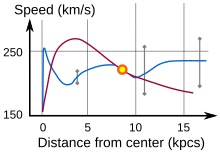
Back هالة المادة المظلمة Arabic Halo de matèria fosca Catalan Dunkle-Materie-Halo German هاله ماده تاریک Persian Halo de matière noire French הילת חומר אפל HE Halo tamne tvari Croatian Alone oscuro Italian 암흑물질 헤일로 Korean തമോദ്രവ്യവലയം Malayalam

In modern models of physical cosmology, a dark matter halo is a basic unit of cosmological structure. It is a hypothetical region that has decoupled from cosmic expansion and contains gravitationally bound matter.[1] A single dark matter halo may contain multiple virialized clumps of dark matter bound together by gravity, known as subhalos.[1] Modern cosmological models, such as ΛCDM, propose that dark matter halos and subhalos may contain galaxies.[1][2] The dark matter halo of a galaxy envelops the galactic disc and extends well beyond the edge of the visible galaxy. Thought to consist of dark matter, halos have not been observed directly. Their existence is inferred through observations of their effects on the motions of stars and gas in galaxies and gravitational lensing.[3] Dark matter halos play a key role in current models of galaxy formation and evolution. Theories that attempt to explain the nature of dark matter halos with varying degrees of success include cold dark matter (CDM), warm dark matter, and massive compact halo objects (MACHOs).[4][5][6][7]

- ^ a b c Wechsler, Risa; Tinker, Jeremy (September 2018). "The Connection between Galaxies and their Dark Matter Halos". Annual Review of Astronomy and Astrophysics. 56: 435–487. arXiv:1804.03097. Bibcode:2018ARA&A..56..435W. doi:10.1146/annurev-astro-081817-051756. S2CID 119072496.
- ^ Mo, Houjun; van den Bosch, Frank; White, Simon (2010). Galaxy Formation and Evolution. Cambridge University Press. pp. 97–98. ISBN 978-0-521-85793-2.
- ^ Khullar, Gourav (4 November 2016). "The Bullet Cluster – A Smoking Gun for Dark Matter!". Astrobites. Retrieved 30 May 2019.
- ^ Navarro, Julio F.; Frenk, Carlos S.; White, Simon D. M. (May 1996). "The Structure of Cold Dark Matter Halos". The Astrophysical Journal. 462: 563–575. arXiv:astro-ph/9508025. Bibcode:1996ApJ...462..563N. doi:10.1086/177173. S2CID 119007675.
- ^ Lovell, Mark R.; Frenk, Carlos S.; Eke, Vincent R.; Jenkins, Adrian; Gao, Liang; Theuns, Tom (21 March 2014). "The properties of warm dark matter haloes". Monthly Notices of the Royal Astronomical Society. 439 (1): 300–317. arXiv:1308.1399. doi:10.1093/mnras/stt2431. S2CID 55639399.
- ^ Alcock, C (10 October 2000). "The MACHO Project: Microlensing Results from 5.7 Years of Large Magellanic Cloud Observations". The Astrophysical Journal. 542 (1): 281–307. arXiv:astro-ph/0001272. Bibcode:2000ApJ...542..281A. doi:10.1086/309512. S2CID 15077430.
- ^ Alcock, C (20 September 2000). "Binary Microlensing Events from the MACHO Project". The Astrophysical Journal. 541 (1): 270–297. arXiv:astro-ph/9907369. Bibcode:2000ApJ...541..270A. doi:10.1086/309393. S2CID 119498357.
- ^ Peter Schneider (2006). Extragalactic Astronomy and Cosmology. Springer. p. 4, Figure 1.4. ISBN 978-3-540-33174-2.
- ^ Theo Koupelis; Karl F Kuhn (2007). In Quest of the Universe. Jones & Bartlett Publishers. p. 492; Figure 16–13. ISBN 978-0-7637-4387-1.
Milky Way rotation curve.
- ^ Mark H. Jones; Robert J. Lambourne; David John Adams (2004). An Introduction to Galaxies and Cosmology. Cambridge University Press. p. 21; Figure 1.13. ISBN 978-0-521-54623-2.
© MMXXIII Rich X Search. We shall prevail. All rights reserved. Rich X Search